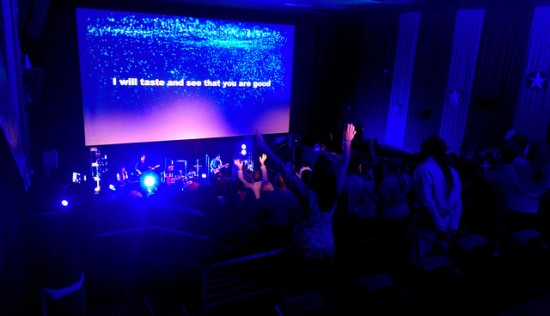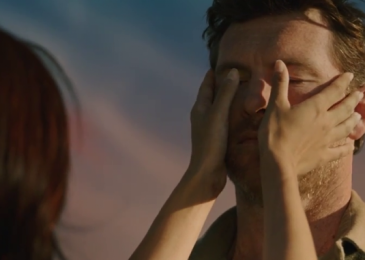Photo by PortableChurch, Flickr. CC Licensing.
When I was in my twenties, my friends referred to the movies as my second church. I could be found there probably as often as I could be found at my regular house of worship, and I probably extolled some films with the same fervor I used when talking about doctrine.
When I was asked to participate in the Patheos symposium on nontraditional worship, I was surprised that churches that meet in movie theaters were considered “nontraditional.” It’s been pretty common in my neck of the woods for at least a decade. It fulfills a practical need, offering many church plants a place to gather until they can afford funds for their own building. Movie theaters offer space for hundreds of people to meet, often with a decent sound system and a giant screen for projecting those Chris Tomlin lyrics. And hey, sticking around for a post-sermon viewing of “Finding Dory” beats hitting the local Applebee’s.
There’s, admittedly, not much different about having Sunday service in a traditional church building or in a movie theater. The Church is not a building; it’s people drawn together to worship and serve. Whether that’s on the hardwood pews of an old Baptist chapel or in the stadium seating of a multiplex, it doesn’t really matter. The real mission of the church is not what goes on in a building on Sunday morning but how that spills out during the week.
Still, there’s a certain redemptive aspect to it. For many years, Hollywood was a target of Christians. Growing up in a conservative Baptist church, my family signed a form promising not to set foot in a movie theater because of its association with lust, violence and greed. Sometimes, though, I wondered if the church was just afraid of competition. After all, in American culture, movie theaters are one of the last few communal gathering places. Where else can you sit alongside strangers and be moved to tears or inspiration by a story, sharing the same emotional journey even if your lives look nothing the same?
Few things frustrate me more than the idea of empty entertainment. The worst movies aren’t the kind that offend me or make me angry; they’re the ones that are completely forgettable. They are the times where I’ve stared at light on a screen for two hours, been suitably distracted and then left, never to think about it again.
And yet, our approach to church — whether we gather at the local theater or under a steeple — is so often just as empty. We come in and take our seat. We let the music wash over us; we grimace if there’s a song we don’t like. We’re told a story that we may nod off during. We turn to the person next to us afterward and mumble something along the line of “that was a good show/service” and then we leave, not really thinking much about it until we do it again in seven days.
When I go to the movies, I want to be moved. I want to laugh and cry. I want to be thrilled. I want to see things I’ve never seen before and have my imagination engaged. In the best moments, I want transcendence. I want whatever plays on that screen to change me, to have me think about life in new ways. I want to leave transformed. For me, enjoying a movie doesn’t stop with the credits; in fact, that’s often just prelude to the joy. I want to leave evangelistic about a film, telling everyone why they should stop whatever they’re doing and go see something amazing. I want to write about it because putting those thoughts into words further embeds a cinematic experience into my soul and helps me truly understand what I think about it. I want to chew on a film and figure out just what magic the director worked that he or she was able to provoke such an experience. And I want to hold on to that as long as possible, let it soak in, and then bring other people back to share in the wonder.
The radical thing isn’t for congregations to meet in movie theaters, but to start approaching church the same way that film lovers approach cinema. Not as consumers to whom a solid rendition of “Oh Happy Day” holds the same amount of entertainment value as explosions in a Michael Bay film, but as people who show up wanting transcendence and transformation. What if we engaged with worship as fully as we do film, letting it move us to laughs, tears and raised hands? What if worship services — from the corporate singing to the offertory to the sermon — were composed with just as much dedication to the concerns of the spirit and the emotional needs of the congregation as to issues of doctrine? What if we spent days chewing over the sermon, debating it with others, examining the things that didn’t make sense and engaging with the things that offended us, letting it change us and, in a sense, taking the time to “critique” it to find its deeper meanings? What if we were as eager to bring our friends with us to be moved, encouraged and transformed by the community that gathers as we were to grab a few friends and see the latest blockbuster again?
In a sense, a movie theater is like a second church to me. In it, I’ve been transformed. I’ve been challenged. I’ve been moved. The depths of my soul have have plumbed by great artists and I’ve bonded with others over shared film experiences. I’ve had those same experiences in church. The two have a lot more in common than we might like to admit. But both speak to longings in our soul for something greater than ourselves. And maybe the most nontraditional thing we can do is to stop treating it all as a diversion.
The Monthly Catch: ‘Vertigo,’ ‘A.I.,’ ‘O.J.,’ Evolution and Sarah BesseyNo, ‘Independence Day’ was not your generation’s ‘Star Wars’Orlando: Death in our safe spaces demands love across the linesThe strange love affair between Christians and guns « The Monthly Catch: ‘Vertigo,’ ‘A.I.,’ ‘O.J.,’ Evolution and Sarah Bessey






